Kyu Han
LAD-RAG: Layout-aware Dynamic RAG for Visually-Rich Document Understanding
Oct 08, 2025



Abstract:Question answering over visually rich documents (VRDs) requires reasoning not only over isolated content but also over documents' structural organization and cross-page dependencies. However, conventional retrieval-augmented generation (RAG) methods encode content in isolated chunks during ingestion, losing structural and cross-page dependencies, and retrieve a fixed number of pages at inference, regardless of the specific demands of the question or context. This often results in incomplete evidence retrieval and degraded answer quality for multi-page reasoning tasks. To address these limitations, we propose LAD-RAG, a novel Layout-Aware Dynamic RAG framework. During ingestion, LAD-RAG constructs a symbolic document graph that captures layout structure and cross-page dependencies, adding it alongside standard neural embeddings to yield a more holistic representation of the document. During inference, an LLM agent dynamically interacts with the neural and symbolic indices to adaptively retrieve the necessary evidence based on the query. Experiments on MMLongBench-Doc, LongDocURL, DUDE, and MP-DocVQA demonstrate that LAD-RAG improves retrieval, achieving over 90% perfect recall on average without any top-k tuning, and outperforming baseline retrievers by up to 20% in recall at comparable noise levels, yielding higher QA accuracy with minimal latency.
The Interspeech 2025 Speech Accessibility Project Challenge
Jul 29, 2025Abstract:While the last decade has witnessed significant advancements in Automatic Speech Recognition (ASR) systems, performance of these systems for individuals with speech disabilities remains inadequate, partly due to limited public training data. To bridge this gap, the 2025 Interspeech Speech Accessibility Project (SAP) Challenge was launched, utilizing over 400 hours of SAP data collected and transcribed from more than 500 individuals with diverse speech disabilities. Hosted on EvalAI and leveraging the remote evaluation pipeline, the SAP Challenge evaluates submissions based on Word Error Rate and Semantic Score. Consequently, 12 out of 22 valid teams outperformed the whisper-large-v2 baseline in terms of WER, while 17 teams surpassed the baseline on SemScore. Notably, the top team achieved the lowest WER of 8.11\%, and the highest SemScore of 88.44\% at the same time, setting new benchmarks for future ASR systems in recognizing impaired speech.
Speech Retrieval-Augmented Generation without Automatic Speech Recognition
Dec 21, 2024



Abstract:One common approach for question answering over speech data is to first transcribe speech using automatic speech recognition (ASR) and then employ text-based retrieval-augmented generation (RAG) on the transcriptions. While this cascaded pipeline has proven effective in many practical settings, ASR errors can propagate to the retrieval and generation steps. To overcome this limitation, we introduce SpeechRAG, a novel framework designed for open-question answering over spoken data. Our proposed approach fine-tunes a pre-trained speech encoder into a speech adapter fed into a frozen large language model (LLM)--based retrieval model. By aligning the embedding spaces of text and speech, our speech retriever directly retrieves audio passages from text-based queries, leveraging the retrieval capacity of the frozen text retriever. Our retrieval experiments on spoken question answering datasets show that direct speech retrieval does not degrade over the text-based baseline, and outperforms the cascaded systems using ASR. For generation, we use a speech language model (SLM) as a generator, conditioned on audio passages rather than transcripts. Without fine-tuning of the SLM, this approach outperforms cascaded text-based models when there is high WER in the transcripts.
Wav2Seq: Pre-training Speech-to-Text Encoder-Decoder Models Using Pseudo Languages
May 02, 2022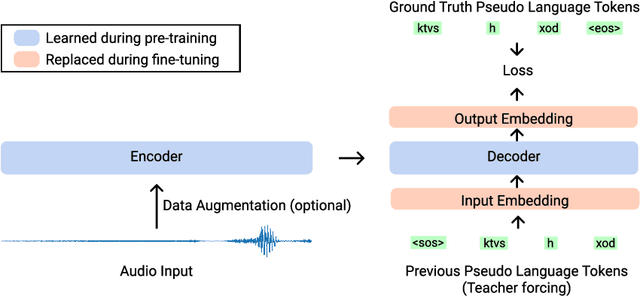
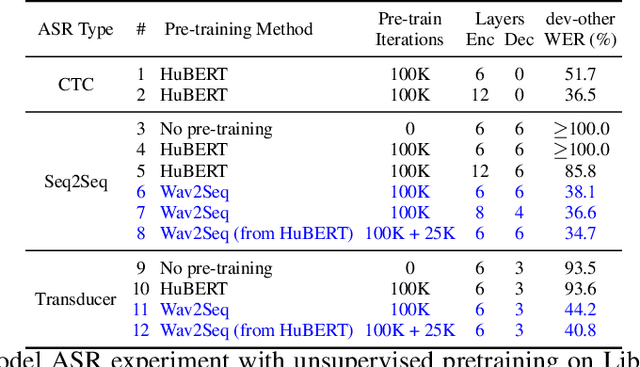
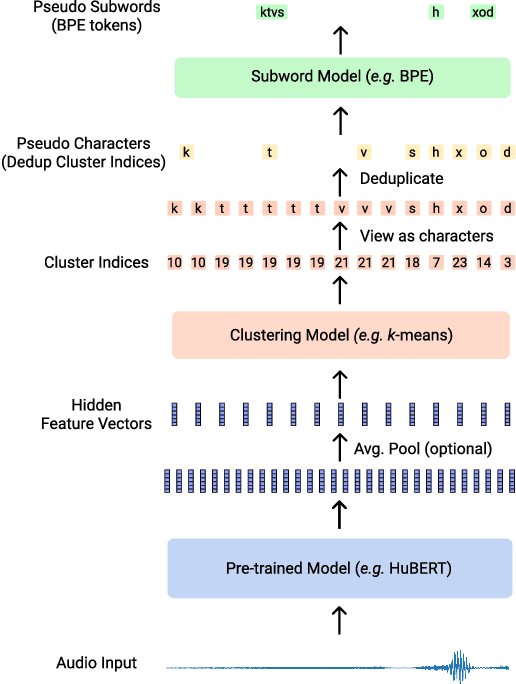

Abstract:We introduce Wav2Seq, the first self-supervised approach to pre-train both parts of encoder-decoder models for speech data. We induce a pseudo language as a compact discrete representation, and formulate a self-supervised pseudo speech recognition task -- transcribing audio inputs into pseudo subword sequences. This process stands on its own, or can be applied as low-cost second-stage pre-training. We experiment with automatic speech recognition (ASR), spoken named entity recognition, and speech-to-text translation. We set new state-of-the-art results for end-to-end spoken named entity recognition, and show consistent improvements on 20 language pairs for speech-to-text translation, even when competing methods use additional text data for training. Finally, on ASR, our approach enables encoder-decoder methods to benefit from pre-training for all parts of the network, and shows comparable performance to highly optimized recent methods.
SRU++: Pioneering Fast Recurrence with Attention for Speech Recognition
Oct 11, 2021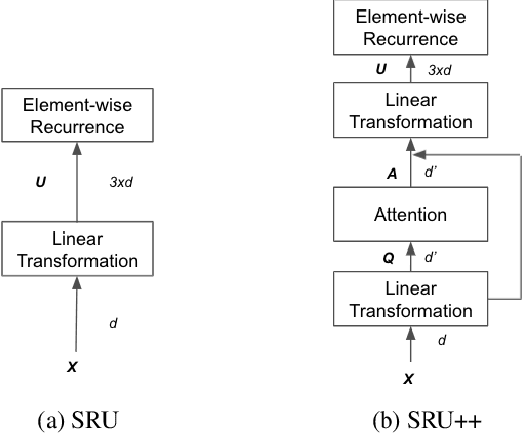
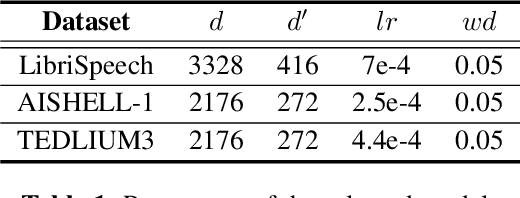


Abstract:The Transformer architecture has been well adopted as a dominant architecture in most sequence transduction tasks including automatic speech recognition (ASR), since its attention mechanism excels in capturing long-range dependencies. While models built solely upon attention can be better parallelized than regular RNN, a novel network architecture, SRU++, was recently proposed. By combining the fast recurrence and attention mechanism, SRU++ exhibits strong capability in sequence modeling and achieves near-state-of-the-art results in various language modeling and machine translation tasks with improved compute efficiency. In this work, we present the advantages of applying SRU++ in ASR tasks by comparing with Conformer across multiple ASR benchmarks and study how the benefits can be generalized to long-form speech inputs. On the popular LibriSpeech benchmark, our SRU++ model achieves 2.0% / 4.7% WER on test-clean / test-other, showing competitive performances compared with the state-of-the-art Conformer encoder under the same set-up. Specifically, SRU++ can surpass Conformer on long-form speech input with a large margin, based on our analysis.
Performance-Efficiency Trade-offs in Unsupervised Pre-training for Speech Recognition
Sep 14, 2021
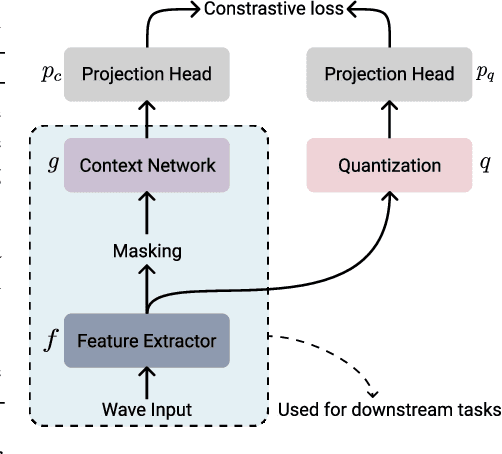
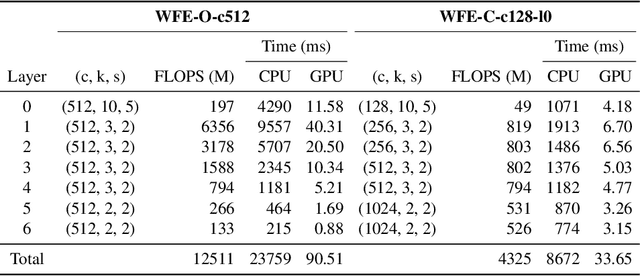
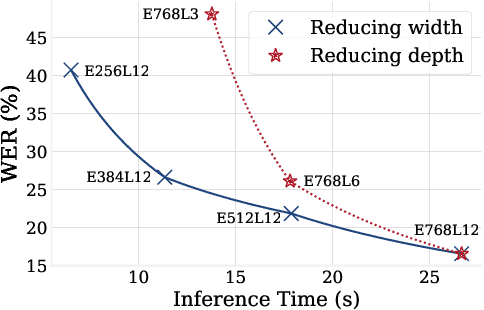
Abstract:This paper is a study of performance-efficiency trade-offs in pre-trained models for automatic speech recognition (ASR). We focus on wav2vec 2.0, and formalize several architecture designs that influence both the model performance and its efficiency. Putting together all our observations, we introduce SEW (Squeezed and Efficient Wav2vec), a pre-trained model architecture with significant improvements along both performance and efficiency dimensions across a variety of training setups. For example, under the 100h-960h semi-supervised setup on LibriSpeech, SEW achieves a 1.9x inference speedup compared to wav2vec 2.0, with a 13.5% relative reduction in word error rate. With a similar inference time, SEW reduces word error rate by 25-50% across different model sizes.
Speaker Diarization With Lexical Information
Nov 28, 2018
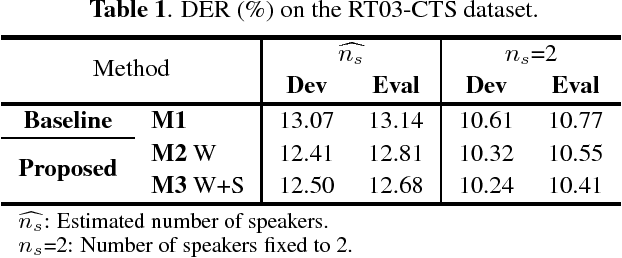
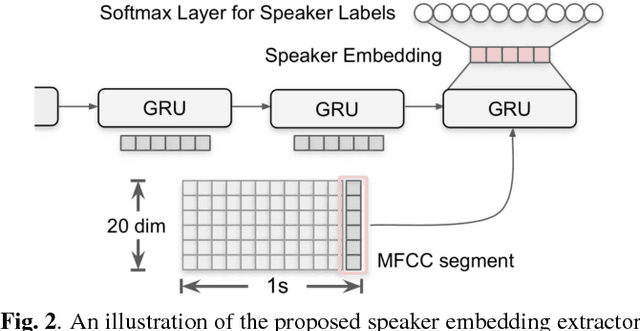
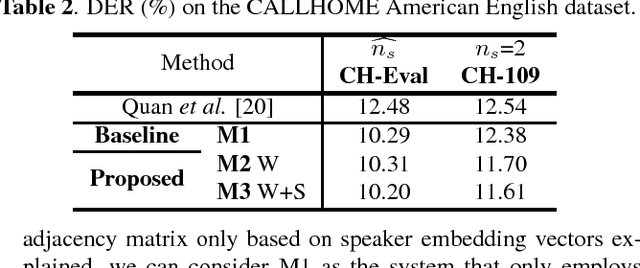
Abstract:This work presents a novel approach to leverage lexical information for speaker diarization. We introduce a speaker diarization system that can directly integrate lexical as well as acoustic information into a speaker clustering process. Thus, we propose an adjacency matrix integration technique to integrate word level speaker turn probabilities with speaker embeddings in a comprehensive way. Our proposed method works without any reference transcript. Words, and word boundary information are provided by an ASR system. We show that our proposed method improves a baseline speaker diarization system solely based on speaker embeddings, achieving a meaningful improvement on the CALLHOME American English Speech dataset.
 Add to Chrome
Add to Chrome Add to Firefox
Add to Firefox Add to Edge
Add to Edge